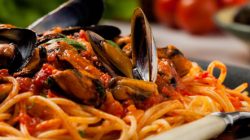Improve Food Products and Menu Development with Fusebiquity
When deciding what food product to purchase in store, order at a restaurant or cook at home, it’s easy to fall back into the comfort of your well-known favorites. Rarely, do the ‘ol tried-and-trues have to compete against the risk of the unknown or the thrill of experimentation.
But what if you brought those two elements together? Stirring comfort in with novelty, the “fusebiquity” trend combines the best of both worlds into one delicious meal.
Let’s examine what fusebiquity is, and how it can enhance the flavor of food products as well as bring excitement to any menu creation.
What is Fusebiquity?
Fusebiquity was first coined by Jack Li, the founder of food insights agency, Dataessential, during the 2019 Multi-Unit Foodservice Operators (MUFSO) conference. Li defines fusebiquity as ubiquitous food items, familiar to the consumer’s palette, which are infused with new elements from different parts of the world.
Examples of Fusebiquity
More and more dishes are created fusebiquitously, following this rising trend. One example is California Pizza Kitchen’s citrus adobo pizza. The classic Italian pie is the more easily recognizable portion of this cultural blend; however, it’s topped with Mexican pulled pork carnitas cooked in ancho chili adobo sauce. These lesser known (to non-Mexican consumers) food items are thus presented over the widely popular pizza base.
Or consider New York Fries’ butter chicken poutine (classic fries, topped with Canadian cheese curds and Indian butter chicken) and South St. Burger’s Hawaiian burger (where the customary combination of an angus beef patty, bacon and lettuce is spiced up with the addition of Hawaiian style ginger glazed pineapple, wasabi mayo and hot pepper relish).
The Popularity of Fusebiquity
While not all chefs use the term ‘fusebiquity’ to describe their flavorful creations, they certainly employ the spirit of what it represents.
When we see how easily flavor and dishes can evolve, it’s easy to see why fusebiquity is so popular. Fusebiquitous meals take the edge off of completely new food experiences as novel elements are introduced in a familiar setting. From a consumer’s perspective, even if one portion of a dish poses an uncertainty, there’s the rest to fall back on. This lowers the barrier for many patrons who might otherwise have passed on trying something they felt was too ‘out there’.
At the same time, fusebiquity adds adventure to traditional foods. An increasing number of people, especially younger generations, are looking to try new flavors and experiences. This is particularly true nowadays as more of us are staying home and enjoying home-cooked meals.
Adding Fusebiquity Elements to Your Menu
So, while most home chefs can cook up a classic mac and cheese with their eyes closed, Tonjiru miso soup might be out of their reach without the right ingredients, tools and culinary knowledge. But that doesn’t mean they aren’t interested. Dataessential finds that, whenever they eat out, quarantine and post-quarantine consumers are most excited to try global cuisines they can’t replicate at home, hence the popularity of the fusebiquity’s experimentation aspect.
Perhaps, serving miso pork mac and cheese (with our 6107 white miso powder) could be the perfect way to strike that balance for your next meal.
At Nikken Foods, we offer high quality natural seafood, vegetable and fermented grains extracts which can be used to infuse unique flavors to your dishes. Try some of our favorite fusebiquity-inspired recipes, such as the deeply umami seaweed barley risotto, sweet and airy chocolate miso air cookies and Hawaiian-style Huli Huli teriyaki.
Contact our food scientists today to develop the perfect food product to elevate your menu.

